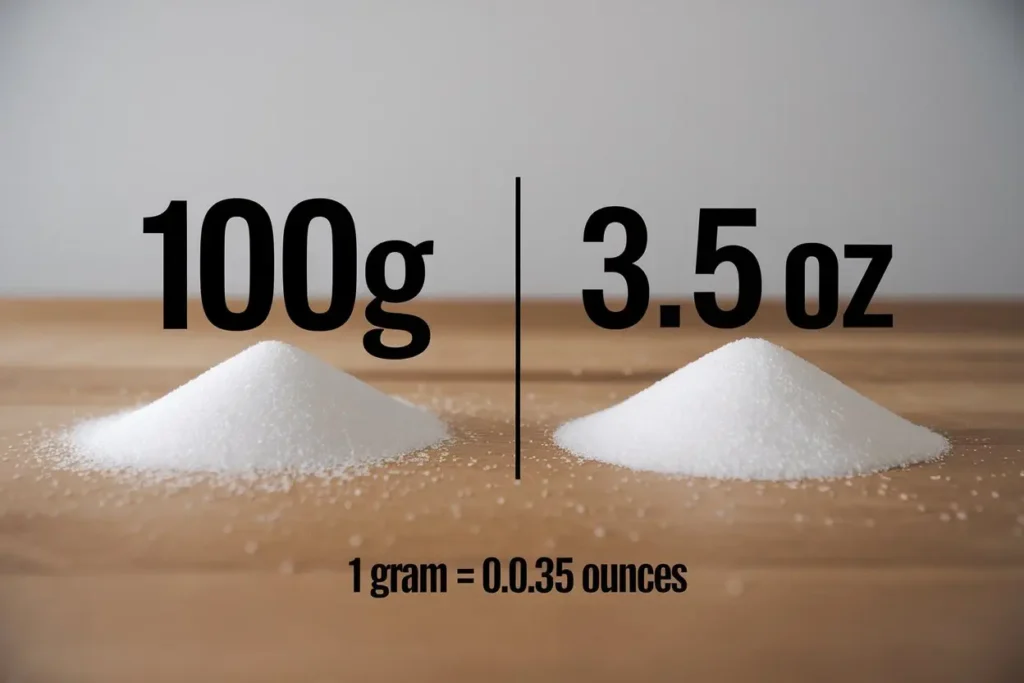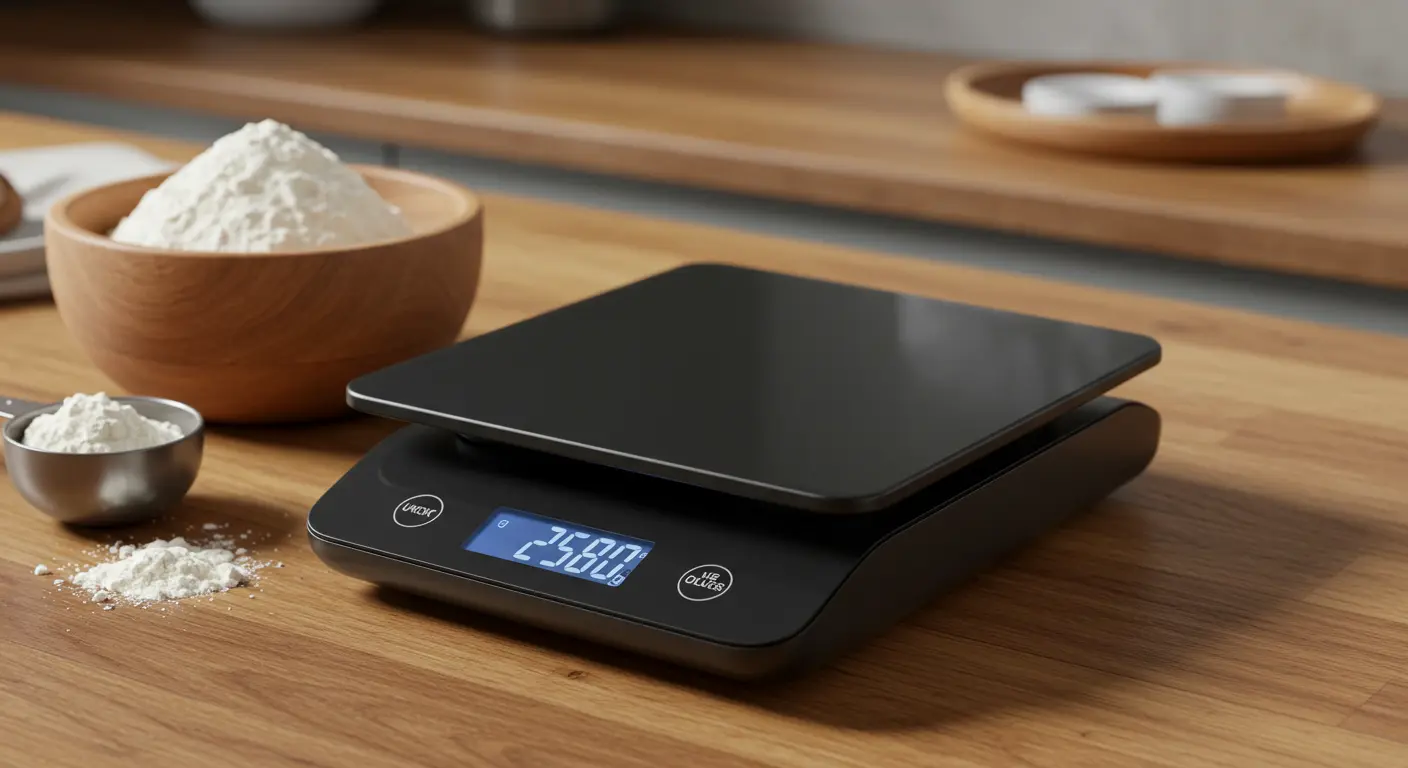Unlock the power of precise measurement with our 100 Grams to Ounces Converter! Whether you’re converting 100 grams or 150 grams, our guide makes it a breeze. Discover how easy it is to transition from 100 grams to ounces and enhance your culinary and scientific endeavors. Start mastering conversions today!
Table of Contents
How Do You Convert 100 Grams to Ounces?
To convert 100 grams to ounces, you can use the conversion factor where 1 ounce (oz) is approximately equal to 28.35 grams. Therefore, to find the number of ounces in 100 grams, divide 100 by 28.35, which results in about 3.5 oz. This means that 100 grams is approximately equal to 3.5 ounces.
If you need other conversions, 200 grams would be roughly 7 oz, while 150 grams is approximately 5.3 oz. For larger quantities, 400 grams equals about 14.1 oz, and 500 grams is equivalent to 17.6 oz. Understanding these conversions can be particularly useful in cooking and nutrition.
What is the formula to convert grams to ounces?
To convert grams to ounces, you can use the formula: 1 oz = 28.35 g. This means that to find the ounce equivalent of 100 grams, you would divide 100 by 28.35, resulting in approximately 3.53 oz. For larger amounts, such as 400 grams, the calculation yields around 14.11 oz. Notably, 150 grams is nearly 5.29 oz, and 200 grams converts to around 7.05 oz.
For quick reference, here are some common conversions: 30 grams is about 1.06 oz, while 500 grams equates to approximately 17.64 oz. If you need to convert 1 kilogram, remember it equals 35.27 oz. Utilizing these conversions facilitates accurate measurements, especially when cooking or preparing sauce.
How many ounces are in 100 grams?
To convert 100 grams into ounces, it’s essential to know that 1 ounce is approximately equal to 28.35 grams. Therefore, 100 grams is roughly equal to 3.5 ounces (oz). More precisely, this means that 100 grams is about 3.53 oz when calculated. For those looking to convert larger amounts, 400 grams would be approximately 14.11 oz, while 200 grams equals 7.05 oz.
In practical terms, if you frequently measure in ounces, knowing that 10 oz is approximately 283.5 grams can help. Understanding these conversions can simplify cooking and baking processes, especially when dealing with various ingredients. For instance, 150 grams translates to about 5.29 oz, providing a clearer picture of ingredient quantities for recipes.
Can I use a converter for different measurements?
Using a converter for different measurements is essential for precise cooking and baking. For instance, if you need to convert 200g into ounces, you would find it equals approximately 7oz. Similarly, 100 grams translates to about 3.5oz. Understanding these conversions can help you accurately measure ingredients, whether it’s 150g of flour or 5oz of butter, ensuring your recipes turn out perfectly every time.
When working with larger measurements, such as 500g, you might need to convert it to 17.6oz or even 1.1 lbs. Familiarizing yourself with various conversions, such as 12oz being equivalent to 340g or 16oz to 450g, can streamline your cooking process. Always keep handy a reliable conversion chart to assist with measurements like 40oz or 8oz, making your culinary adventures easier.

Why is Grams to Ounces Conversion Important?
Understanding the conversion from grams to ounces is crucial in both culinary and scientific contexts. For instance, recipes might call for 150 grams of an ingredient, which translates to approximately 5.3 ounces. Accurate measurements ensure the correct balance of flavors and nutrients, especially when dealing with larger quantities like 400 grams or 700 grams, which would convert to about 14.1 ounces and 24.7 ounces, respectively.
In nutrition, knowing these conversions can aid in calorie counting and portion control. For example, a 100-gram serving of a food item provides essential data for dietary planning. Whether one is measuring 90 grams or 30 grams, understanding how these amounts relate to ounces, such as 3.2 ounces for 90 grams, facilitates better health choices.
Moreover, in commercial settings, precise conversions can impact product labeling and compliance with regulations. For instance, a product labeled as 200 grams must accurately reflect its weight in ounces for consumer clarity, equating to roughly 7.1 ounces. This knowledge ensures that both consumers and producers maintain trust through transparency.
What are common uses for ounce and gram conversions?
Common uses for ounce and gram conversions include cooking and nutrition. For instance, a recipe may call for 10oz of chicken, which translates to approximately 300g. Similarly, when tracking dietary intake, individuals often convert 50g of almonds into 1.76oz to better understand their nutritional value. Additionally, packaging for food items often uses both measurements, such as a 120g snack, equivalent to about 4.2oz, making it easier for consumers to gauge serving sizes.
In scientific settings, precise conversions are critical; for example, a 200-gram sample might need to be measured in 7oz for certain experiments. Furthermore, weight conversions are crucial in industries like shipping, where a package weighing 150 grams could be listed as 5.29oz. Understanding these conversions helps maintain accuracy across various fields such as cooking, nutrition, and logistics.
How does understanding conversions help in cooking?
Understanding conversions is essential in cooking, as it ensures precise measurements for consistent results. For instance, knowing that 1 kg equals 1000 grams can help you scale recipes effectively. If a recipe calls for 300 grams of flour, and you only have a 5 kg bag, you can easily calculate that you’ll need about 6 oz to meet the requirement.
Moreover, conversions between oz and grams are crucial when dealing with ingredients. Understanding that 1 oz is approximately 28.35 grams allows you to convert measurements accurately, ensuring that your dish turns out perfectly every time. For instance, if you need 150 grams of sugar, you can determine that this is roughly 5.29 oz.
Additionally, mastering metric conversions, such as knowing that 400 grams is about 14 oz, can be a game-changer in meal prep. Whether you’re cooking for a small family or preparing a meal for 20, understanding these conversions can make a significant difference in achieving culinary excellence.
Are there health reasons for measuring food in grams or ounces?
Measuring food in grams or ounces is essential for accurate portion control, which can aid in managing weight and nutritional intake. For example, 100 grams of protein contains approximately 21 grams of protein, while 4 oz of a food item can provide a different nutritional profile.
Tracking food with precision, such as 150 grams or 3.4 oz, helps individuals meet dietary goals. Adhering to recommended serving sizes—like 80 g of carbohydrates or 200 grams of vegetables—ensures a balanced diet for improved health.
Moreover, using measurements like 11 oz for liquids or 400 grams for bulk items can prevent overconsumption. Therefore, understanding these metrics, such as 1 gram or 2 oz, is crucial for making healthier food choices and achieving dietary success.
What Tools Can Help Me Convert 100 Grams to Ounces?
To convert 100 grams to ounces, you can use various tools such as online calculators, conversion charts, or smartphone apps. Remember that 100 gm is approximately 3.53 oz, which is useful when dealing with common weights like 150 grams or 400 grams.
For precise measurement, you can also use a scale that provides both grams and ounces. Understanding that 1 gram equals 0.035 oz can help you convert other values like 80g or 200 grams easily. Each method will ensure you achieve accurate results.
What online converters are available for oz to g?
Online converters for oz to g are widely available, offering quick and efficient conversions. For example, 1oz is approximately 28.35g, making it easy to convert 11oz to 311g or 14oz to 396g. Many tools also handle larger measurements, such as 400 grams or 800 g.
These converters simplify calculations for various needs, whether converting 12oz to 340g or 6oz to 170g. Users can effortlessly change measurements, such as 100 grams to 3.5oz or 150 grams to 5.3oz, ensuring accuracy in recipes or nutritional tracking.
With features that allow for conversions of 30g to 1oz or 90g to 3.2oz, these tools cater to various requirements. Ranging from 2oz to 350g, online converters are essential for anyone needing precise measurements. The ease of use makes them a popular choice for quick gramm to oz conversions.
Are there apps that assist with conversion?
There are numerous apps available that assist with the conversion of various measurements. For instance, users can convert 50 grams to ounces, where 100 grams equals approximately 3.5oz, providing an easy reference for cooking or baking.
Some apps also allow conversions from 400 grams to kilos, indicating that 1 kilo is equivalent to 1000 grams. This is particularly useful for maintaining correct ingredient ratios in recipes.
Additionally, with options to convert 150 grams into 5.3oz or 200 grams into 7oz, these tools can significantly enhance culinary efficiency.
How accurate are kitchen scales in measuring grams and ounces?
Kitchen scales typically measure weight with high accuracy, often within 1g for precise readings. Most digital scales can handle a range from 0 to 400 grams, making them suitable for various kitchen tasks, including measuring 100 grams of flour or 3oz of sugar.
For optimal performance, it’s essential to calibrate your scale regularly, as slight variations can occur. A well-calibrated scale can accurately measure small quantities, such as 2.5 grams, or larger amounts, like 150 grams of ingredients, ensuring you achieve perfect results every time.

How Many Ounces Are in Common Gram Measurements?
Understanding the conversion between grams and ounces is essential for cooking and nutrition. For instance, 100 grams is approximately 3.5 oz, while 200 grams converts to around 7 oz. Similarly, 400 grams equals about 14 oz, and 150 grams is close to 5.3 oz. Other common measurements include 100 gm at 3.5 oz, 24 oz for 680 grams, and 9 oz which corresponds to 255 grams.
In larger quantities, 350 grams is about 12.3 oz, while 160 grams translates to 5.6 oz. Notably, 85 grams is roughly 3 oz, and 140 grams equals 4.9 oz. For precise measurements, remember that 1 oz is equal to approximately 28.35 grams, which can help in various cooking contexts.
How much is 200 grams in ounces?
To convert 200 grams to ounces, you can use the conversion factor where 100 grams is approximately 3.5 oz. Thus, 200 grams equals about 7 oz. For reference, 150 grams is close to 5.3 oz, while 400 grams converts to around 14.1 oz.
In more detail, 1 oz is roughly 28.35 grams, so to find 200 grams in ounces, divide 200 grams by 28.35. This calculation yields approximately 7.05 oz, which can be rounded to 7 oz for simplicity.
What is the conversion for 500 grams to ounces?
The conversion for 500 grams to ounces is approximately 17.64 oz. To understand this, note that 100 grams is roughly equal to 3.53 oz, so 400 grams would be about 14.11 oz and 600 grams about 21.16 oz.
Using these conversions, 500 grams can be derived from 100 grams and 400 grams, making it a simple calculation. Additionally, 8 oz is equivalent to 227 grams, further illustrating the conversion process between gr and oz.
How do I convert 1000 grams to ounces?
To convert 1000 grams to ounces, you can use the conversion factor where 1 ounce is approximately 28.35 grams. Therefore, 1000 grams divided by 28.35 equals about 35.27 ounces.
For simpler conversions, remember that 400 grams is roughly 14.11 ounces, and 200 grams is about 7.05 ounces. This means 100 grams equals approximately 3.53 ounces, and 150 grams converts to around 5.29 ounces.
For context, 1000 grams is a significant amount, similar to 2.2 pounds. You can also use 9 ounces as a reference, which is about 255 grams. Thus, knowing these conversions can help in various measurements.
What are the Common Mistakes in Grams to Ounces Conversion?
Common mistakes in grams to ounces conversion often stem from incorrect multiplication or division. For instance, failing to remember that 100 grams is approximately 3.5oz can lead to significant errors in recipes. Similarly, confusing 150 grams with 5.3oz instead of the accurate 5.29oz can affect measurements.
Additionally, rounding errors can occur when converting larger amounts, such as 400 grams to 14.1oz, or 200 grams to 7.05oz. It’s also common to miscalculate 100 gm as 3.5oz instead of recognizing that it equals 3.53oz. Precision is key, especially when measuring 15, 12, or 40 grams.
To avoid these mistakes, always remember the conversion factor: 1oz is approximately 28.35 grams. For instance, 180 grams converts to about 6.35oz, while 110 grams equals roughly 3.88oz. Keeping track of smaller conversions like 9oz or 75 grams can also prevent confusion.
To convert 1000 grams to ounces, you can use the conversion factor that 1 ounce is approximately equal to 28.35 grams. Thus, dividing 1000 grams by 28 gives you about 35.27 oz. For smaller conversions, 100 grams equals about 3.53 oz, and 400 grams is approximately 14.11 oz.
If you need to convert specific amounts, remember that 150 grams translates to about 5.29 oz, while 200 grams is around 7.05 oz. For quick estimates, 100 grams converts to 3.5 oz, providing a handy reference for larger or smaller quantities.
For example, 120 grams would be roughly 4.23 oz, and 170 grams equals approximately 6 oz. Always bear in mind the conversion factor of 28 to ensure accuracy in your measurements. Boom, you’re ready to convert!
What errors should I avoid when converting 100g to oz?
When converting 100 grams to oz, avoid common errors such as using incorrect conversion factors. Remember that 1 oz is approximately 28.35 grams; thus, 100 gm should equal about 3.53oz. Miscalculating can lead to discrepancies, especially when dealing with larger amounts like 200grams or 400grams.
Additionally, be cautious with rounding; for instance, 150 grams converts to about 5.29oz. Always double-check your calculations, particularly when converting values like 125 or 130 grams to ounces. Using precise figures ensures accuracy in measurements.
How can I ensure accuracy in my conversions?
To ensure accuracy in your conversions, always use precise measurements. For instance, remember that 100gm is equivalent to approximately 3.53oz, while 150 grams converts to about 5.29oz. Utilize conversion charts or calculators for more complex amounts, like converting 112 grams to ounces.
Additionally, be cautious with rounding. Converting 4.5 ounces to grams yields 127.57gm, which should be accurately noted as 100 grams or 100 gm for simplification. Always double-check figures to maintain precision in your measurements.
Are tablespoons and teaspoons part of this conversion?
When converting measurements, it’s essential to understand the role of tablespoons and teaspoons. For instance, 100 grams is roughly equivalent to 3.5 ounces, while 150 grams is about 5.3 ounces. Additionally, there are 16 oz in a pound, which is useful for larger conversions.
In cooking, using 100 milliliters translates to approximately 0.4 cups, which can also be measured in teaspoons and tablespoons. Specifically, there are 3 teaspoons in a tablespoon, making these measurements essential for precise cooking and baking.
Grams to Ounces and Ounces to Grams Converter
Accurate measurement conversions are crucial in cooking and baking. Whether you’re converting Grams to Ounces or vice versa, this tool will help you get precise results.
Grams ↔ Ounces Converter
Result: 0

